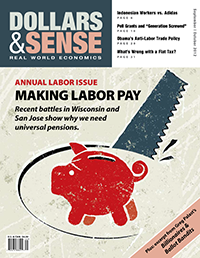Don't Drive Off the Fiscal Cliff
Congress's newest game of chicken threatens the recovery.
The U.S. economy is set to go off the so-called "fiscal cliff" at midnight on December 31, 2012. That's when various tax cuts for people at most income levels will expire. Days later, the federal budget will automatically be cut as the result of an agreement made by both parties last summer, when Congress was in a standoff over the debt ceiling. The deal reached by President Obama and leaders of Congress, called the Budget Control Act of 2011, enabled the federal government to raise its debt ceiling (permitting it to pays its bills) while in turn reducing future budgets. Congress agreed on $1.2 trillion in budget cuts at the time, and tasked a congressional "super committee" with identifying an additional $1.2 trillion in savings. That committee, however, has failed to reach agreement, and now the $1.2 trillion will automatically be cut.

September/October 2012 issue.
What would go over the cliff this coming January is our hope of economic recovery.
If the cuts happen as planned, nearly $500 billion will be cut from the defense budget and the same amount from non-defense spending over the next decade. That, plus about $200 billion of reduced interest payments on the federal debt, gets us to the $1.2 trillion in savings.
But it's not too late for Congress to change its act. There are four alternatives to driving over the fiscal cliff. One: Delay debt reduction. Reducing spending during a fragile time of economic recovery is almost certain to make matters much worse. The Congressional Budget Office (CBO) has estimated that this policy of "fiscal restraint" would result in a contraction of the economy by 1.3% during the first half of 2013. Alternatively, the CBO finds that "reduced fiscal restraint," in which none of the automatic cuts take place and no tax cuts expire, would boost GDP growth in 2013 by 3.9 percentage points more than the current course and would save two million jobs.
The debt can wait. While it's true that the government pays interest on the debt and should therefore not let it rise continuously and unsustainably, Congress could delay debt reduction by a few years until the economy is more stable.
Two: Raise revenue. Deficits, and in turn debt, rise when spending outpaces revenues. To reduce the debt without harming economic recovery, we could raise revenue. This includes strategies such as the Obama administration's proposal to eliminate tax breaks for the wealthy. According to the non-partisan center OMB Watch, allowing tax cuts for the top 2% to expire would generate almost a trillion dollars over the next ten years.
Options three and four are two sides of a very contentious coin. One side is to protect the defense budget. The other is to protect non-defense spending. Each side has nearly $500 billion at stake. But they are far from equal.
Three: Slash non-defense spending. This is vice-presidential candidate Paul Ryan's budget plan. The Ryan budget or, as he calls it, "The Path to Prosperity," cuts important domestic programs while protecting military spending, even as the war in Iraq has ended and the war in Afghanistan is supposedly nearing its end. This option has many vocal supporters.
Four: Maintain non-domestic spending while cutting defense spending. Those trying to protect spending for healthcare, education, national parks, research and development, and infrastructure are neither united nor vocal. Yet in terms of economic prosperity, the choice should be clear. Dollar for dollar, non-military domestic programs create many more jobs than military spending. One billion dollars spent on the military (and related industries) supports about 11,200 jobs in the United States. That same amount spent on healthcare supports 17,200 U.S. jobs; spent on education, 26,700 U.S. jobs. Why do these programs create more jobs, dollar for dollar, than defense? Because they are more labor-intensive than defense: more of the dollars go to pay salaries rather than to buy materials and equipment. And more of non-defense spending stays in the United States. As teachers and healthcare workers spend their income in their towns and cities, they create more demand for food services, healthcare, and other local industries.
The U.S. economy is still not close to a full recovery from the economic crisis. It would be reckless to drive off the fiscal cliff next January. The more responsible option is to raise taxes on the rich, reduce spending on the military, and shift the money that would have been spent on the military over to domestic spending where we get more bang for the buck.
